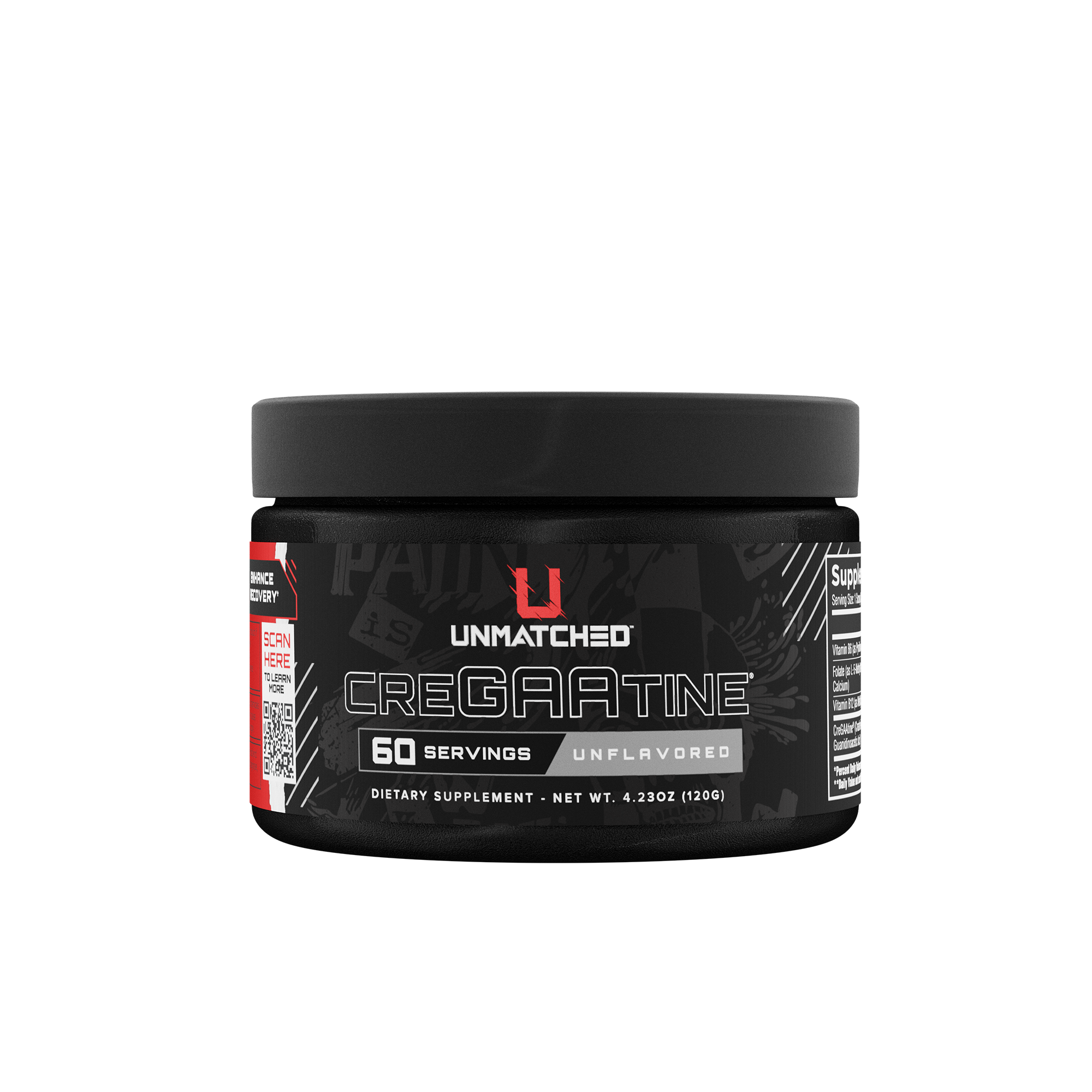Last night, during the AUA inside our private group, one of our amazing members asked about my thoughts on creatine.
Apparently, Rory McIlroy, the recent PGA Masters champ, was caught on tape saying that he takes 20 GRAMS of creatine per day.
Here’s the article if you are interested:
I am a huge fan of creatine.
In fact, I have taken 5 grams daily since the age of 12.
Back then, it was a “bro” supplement.
However, in recent years, the biohacking/longevity community has caught on to using creatine because of its potent ability to improve brain health.
Through the years, different forms of creatine have come and gone, but creatine monohydrate has stood the test of time as the best version.
Until now.
Lately, my good friend Kris Gethin turned me on to a new form of creatine called CreGAAtine.
Based on my recent personal experimentation with this improved form of creatine, I think it will become the preferred form over monohydrate in the coming years.
Before I explain exactly why, let’s briefly revisit why creatine is such a powerhouse.
Creatine Monohydrate: The King of Supplements (Until Now)
Creatine monohydrate has rightly earned its place in almost every supplement regimen.
Whether you’re a biohacker, athlete, or longevity enthusiast, creatine offers remarkable benefits:
Enhanced muscle strength and endurance: Creatine rapidly replenishes ATP, our body’s main energy source during intense activities, improving workout performance and recovery.
Cognitive boost and neuroprotection: It enhances brain energetics, improving memory, mental clarity, and even offering protective effects against cognitive decline.
Mitochondrial and cellular health: Creatine supports mitochondrial efficiency, aiding cellular function, energy metabolism, and overall vitality.
Healthy aging: Supplementation has shown to reduce muscle loss (sarcopenia), improve functional mobility in older adults, and sustain cognitive function over time.
Thousands of studies back these claims.
Creatine monohydrate has consistently proven its safety and effectiveness, making it a go-to choice for virtually anyone aiming for peak performance and longevity.
Enter CreGAAtine
CreGAAtine is a relatively new supplement that combines creatine monohydrate with guanidinoacetic acid (GAA), the direct biochemical precursor to creatine in the body.
Essentially, it’s a synergistic pairing designed to overcome some inherent limitations of traditional creatine.
CreGAAtine amplifies the benefits of creatine significantly, unlocking greater bioavailability, improved muscle and brain uptake, reduced creatinine conversion, and less water retention.
How CreGAAtine Mechanistically Outperforms Traditional Creatine
When you take regular creatine monohydrate, it enters your bloodstream and gets taken up into cells through a single transporter (CRT1).
This pathway can easily become saturated, limiting how much creatine actually enters your cells, especially in your brain.
CreGAAtine solves this problem by adding GAA.
GAA uses separate transport pathways—essentially bypassing that single channel.
Once inside cells, GAA is efficiently converted directly into creatine.
This dual-pathway approach means significantly more creatine actually reaches the tissues that need it most (muscle and brain).
Studies have already demonstrated it:
Higher muscle creatine: One study found CreGAAtine boosted muscle creatine content by a whopping 16.9% compared to just 2% from creatine monohydrate alone.
Superior brain creatine uptake: The same study found CreGAAtine raised brain creatine levels 5.8% versus 1.5% for creatine alone. This increased brain saturation could enhance cognitive performance, memory, and neuroprotection.
Reduced water retention: Early pilot studies suggest CreGAAtine results in noticeably less water retention—meaning you gain strength and muscle without as much of the typical creatine “bloat.”
Early Research and Real-World Evidence
In a pilot study published in Annals of Nutrition and Metabolism, elderly participants saw meaningful improvements in functional mobility and cognitive metrics after supplementing with the creatine-GAA combo for just several weeks.
MRI spectroscopy confirmed the significant rise in muscle and brain phosphocreatine stores—translating into more cellular energy for improved physical and mental performance.
Additionally, researchers proposed that CreGAAtine’s improved bioavailability leads to less wasted creatine (in the form of creatinine), meaning your body uses more of what you’re taking without the harmful by-products.
Safety Considerations
Both creatine monohydrate and GAA have strong safety profiles.
The only cautionary note is that GAA supplementation alone can increase homocysteine levels—an inflammatory marker.
But here’s the cool thing: adding creatine with GAA, as CreGAAtine does, substantially mitigates this risk.
Even better, if you’re cautious like me, taking a methyl donor (like betaine or a methylated B-vitamin complex) alongside CreGAAtine eliminates this concern entirely.
Exactly How I Use CreGAAtine
Here’s exactly how I integrate CreGAAtine into my daily routine:
Training Days:
4 grams pre-workout: About 20-30 minutes before training, to saturate muscle and neural tissue for optimal performance and mental clarity during my workout.
4 grams intra-workout: Mixed directly into my water bottle or intra-workout drink. This maintains elevated levels during intense exercise, sustaining strength, endurance, and mental sharpness throughout the session.
4 grams post-workout: Taken immediately after training to rapidly replenish phosphocreatine stores, kickstarting recovery and reducing muscle fatigue.
Fasting Days:
4 grams first thing in the morning: Even on non-training days, I keep my tissue levels topped up by taking a single dose upon waking. This supports cognitive function, mitochondrial health, and overall cellular energy throughout my fasting period.
My strength and endurance at the gym feel noticeably elevated.
Granted, I am on testosterone, growth hormone, and a few peptides at the moment, but even beyond those, I feel an effect.
But even more compelling for me has been the cognitive enhancement—I’m feeling sharper, more mentally resilient, and just “on point” during extended workdays.
Plus, I’ve noticed significantly less water retention compared to monohydrate, giving a leaner, tighter look—perfect for those of us who prioritize aesthetics alongside performance.
After extensive research and personal experimentation, CreGAAtine has earned a permanent place in my supplement stack.
I genuinely believe it’s the next generation of creatine, particularly suited for folks in our community who want to optimize physical performance and cognitive health simultaneously.
Where to Get Your Hands on CreGAAtine
I always aim to bring you the best recommendations, and for CreGAAtine, there’s no better place to go than Unmatched Supplements.
My good friend Kris Gethin, a respected figure in the fitness world, stands behind this brand for its quality, transparency, and commitment to purity.
Just use the code hunterw at checkout, and you’ll get 10% off.
You can grab yours here: Unmatched Supplements – CreGAAtine
Final Thoughts
Creatine monohydrate served me incredibly well for years, and I still respect it deeply as a foundational supplement.
But as we evolve, we discover better ways to support our bodies and minds.
CreGAAtine is exactly that—an optimized, next-gen creatine supplement offering real, measurable improvements in muscle and brain function.
Best,
Hunter Williams
Further Reading
For those interested in delving deeper into the research behind CreGAAtine, here are some key studies:
Guanidinoacetate-Creatine Supplementation Improves Functional Performance and Muscle and Brain Bioenergetics in the Elderly: A Pilot Study
Seper et al., 2021
This pilot study demonstrated that an 8-week supplementation of GAA and creatine improved functional performance and increased muscle and brain creatine levels in elderly participants.
Co-administration of Creatine and Guanidinoacetic Acid for Augmented Tissue Bioenergetics: A Novel Approach?
Ostojic, 2017
This article discusses how combining creatine with its precursor GAA can enhance tissue bioenergetics by utilizing different transport mechanisms, potentially leading to improved creatine uptake.
Safety of Dietary Guanidinoacetic Acid: A Villain or a Good Guy?
Ostojic, 2021
This review evaluates the safety profile of GAA supplementation, concluding that it is generally safe when used appropriately, with considerations for homocysteine levels.
P.S.
I know today’s email wasn’t the typical “peptide” writeup, but I would appreciate your feedback.

